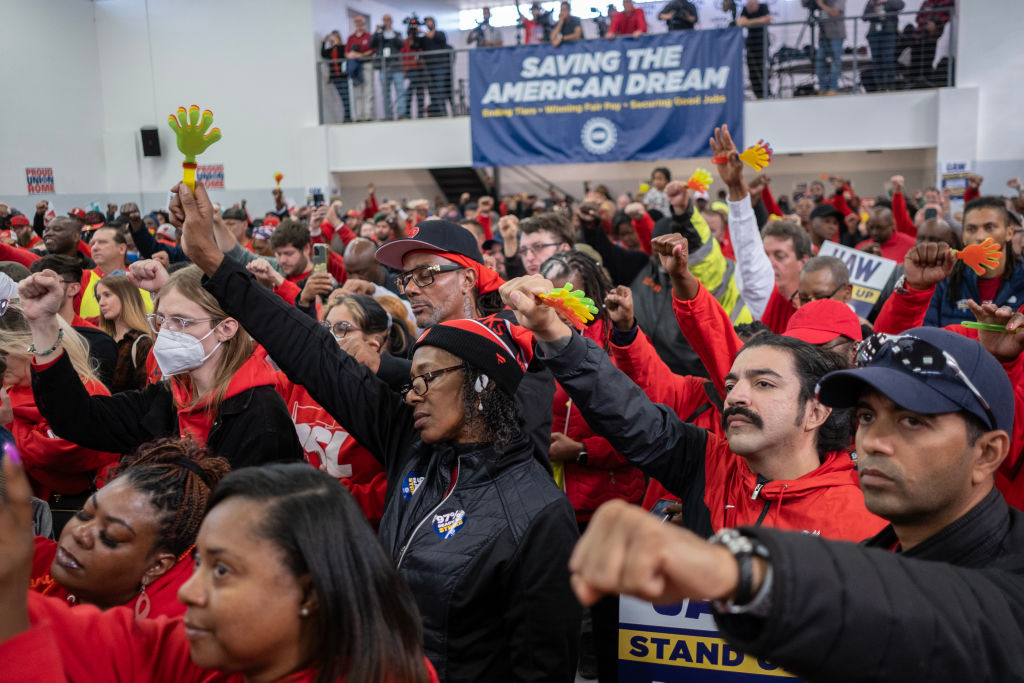
UAW members attend a rally in support of the strike at the UAW Local 551 hall on the South Side on October 7, 2023 in Chicago, Illinois. (Photo by Jim Vondruska/Getty Images)

Share
“The world depends on us, on our labor. And we have the right to decide what kind of world it’s going to be.” As we enter 2024, I reflect on this quote from the late Leo Robinson, Black longshoreman and leader in the ILWU, who played a key role in organizing Local 10’s 1984 boycott of goods shipped from apartheid South Africa.
We face a world beset with cruel injustice, from the harms of human-made climate change to mass displacement crises in Congo and Sudan to the horrific treatment of migrants and refugees here in the United States to the Biden administration’s support for Israel’s onslaught on Gaza, which has killed 20,000 Palestinians.
US workers, themselves, are under attack, facing historically low union density, the fissuring of workplaces, aggressive union busting campaigns, and soaring inequality.
But at the same time, workers are ascendant: In the United States, union enthusiasm is surging, as are rank-and-file union movements for militancy and democracy. It’s no coincidence that the UAW, now helmed by reform challenger Shawn Fain, not only won significant gains in its strike against the ‘Big Three’ Automakers, but is also making plans to organize plants across the country, and now speaking out in favor of a ceasefire in Gaza. This union is joined by growing numbers of working people in the United States who oppose Israel’s bloodshed, with more and more unions (though not all) demanding a ceasefire, their members and elected officers issuing statements, taking to the streets, and lobbying elected officials.
In Minnesota, we are seeing a cross-sectoral campaign to win broad social demands, backed by 13 unions, workers’ centers, and community groups, which is expected to escalate this spring. And there are plenty of other contract battles ahead. The struggle for workers to “decide what kind of world it’s going to be” is being waged on Amazon warehouse floors and in UPS trucks, on auto assembly lines and construction sites, in hospitals and grocery stores, in the informal economy and among incarcerated laborers, among the unemployed and excluded.
At Workday Magazine, we try to remain sober about the challenges and overwhelming power these workers are up against, while holding on to the hope that comes with collective organizing. We strive to take both a hyper-local and international view, focusing on Minnesota and the Midwest, but also the world, premised on the principle that all worker struggles are important, regardless of where those workers happen to live or be from.
Amid a changing climate, and brutal violence enacted by our government, workers are fighting to bring into being a different vision of how the world could be, an effort that is often messy, not always unified, but nonetheless contains the hope of humanity. Here are our favorite 10 stories from 2023 that we think highlight both the stakes, and the aspirations, of this struggle.
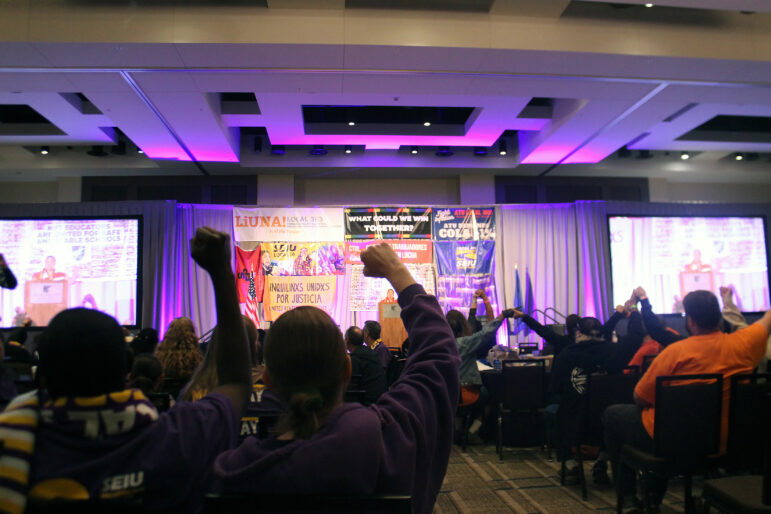
Amie Stager
After a difficult few years, Minnesotan union members are celebrating wins, bringing energy to the labor movement to demand more.1. “What Could We Win Together?” Labor in Minnesota Gears up for a Major Escalation
With a string of contracts expiring in the new year, Minnesota unions and community groups are gathering to unite around a strategy for a cleaner environment and better jobs, housing and schools.
By Isabela Escalona and Amie Stager
2. This Union Is Famous for Opposing South African Apartheid. Now It’s Standing With Gaza.
In 1984, ILWU Local 10 refused to unload goods shipped from South Africa. Today it’s demanding a cease-fire.
By Sarah Lazare
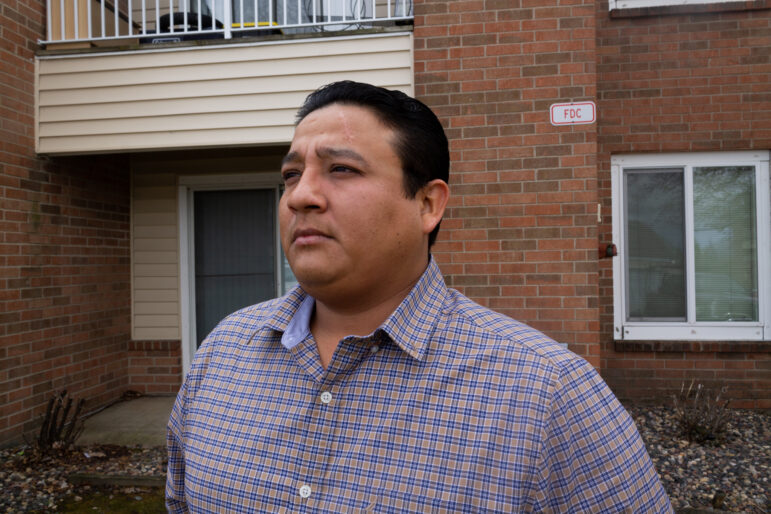
Isabela Escalona
José Alfredo Gómez standing in front of his home. He has a large scar on his forehead from falling two stories while working on a construction site.3. Delayed Care, Stolen Wages: The Human Cost of Worker Misclassification
Misclassification of workers may sound like a clerical error. But in the construction industry, it can lead to wage theft, intimidation, and delayed treatment for workplace injuries.
By Isabela Escalona

Isabela Escalona
Khali Jama, Amazon warehouse worker in Shakopee, Minn.4. High Injury Rates Push Minnesota’s Amazon Workers to Organize for Safety
Workers are concerned about soaring rates of injury, high productivity quotas, incoherent policies, and a sudden warehouse closure.
By Isabela Escalona
5. How Biden Can End Secretive Corporate Tribunals
The president has promised not to put anti-democratic investor-state dispute settlement mechanisms in future trade deals. But they are still in many existing ones.
By Sarah Lazare
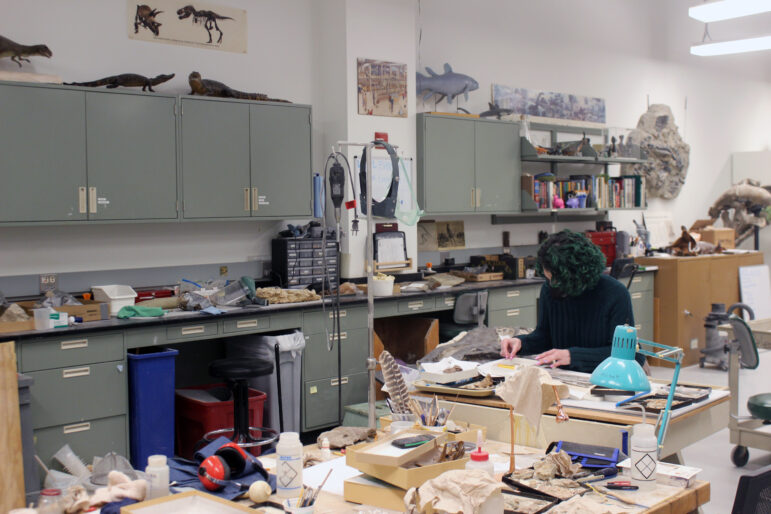
Amie Stager
Nicole Dzenowski cares for a fossil stored in the paleontology lab that she manages at the Science Museum of Minnesota.6. “We Can’t Eat Prestige”: Inside the Unionization of the Science Museum of Minnesota
The NLRB recently reinstated six workers at the Science Museum of Minnesota. Workers say the museum is still breaking labor law and failing to bargain in good faith.
By Amie Stager
7. Minnesota Women Labor Journalists Uplifted Working People for Decades
Was objectivity really a historical norm? Not for these pioneering labor journalists and advocates.
By Amie Stager
8. Master Lock closes its plant in Milwaukee after 100 years
A short documentary covering the closure of the Master Lock factory in Milwaukee, Wisconsin, centering the stories of two long-time employees and why the union job was important for them and their community.
By Isabela Escalona

Sarah Lazare
Larry Hopkins says he is starting to worry about his health. “Every day that I work, I’m being exposed to the diesel fumes that are bad for our communities,” says the 56-year-old who was born in Blytheville, Arkansas, and now lives on the southwest side of Chicago.9. The Filthy Emissions of Railroad Locomotives—and the Rail Unions Sounding the Alarm
Diesel engines have gotten a sweetheart deal from environmental regulators. It’s time that changed.
By Sarah Lazare
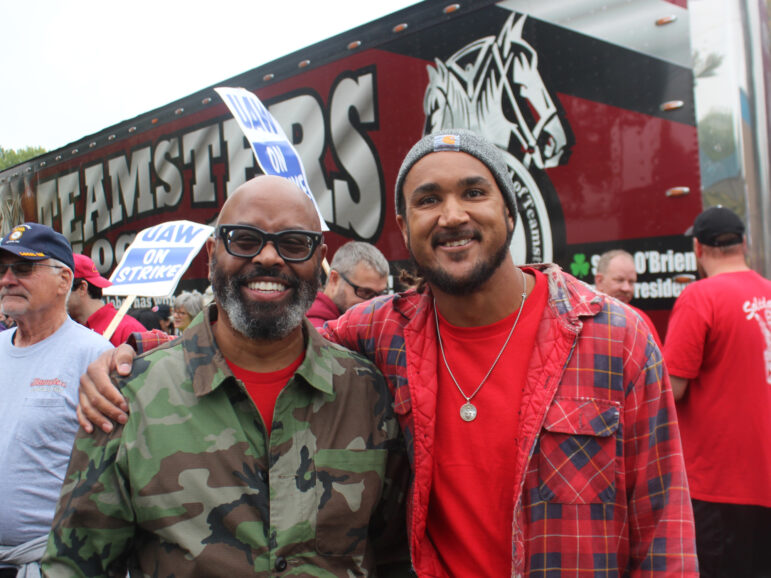
Amie Stager
Alex Tivis, who has worked at the Mopar Parts Distribution Warehouse in Plymouth, Minn., for nine years, poses with his father, David Kirby, who has worked at the warehouse for 25 years.“I want to see them return what they promised to the workers that saved the company,” says a striking Stellantis worker in Minnesota.
By Amie Stager
(Big thanks to our publishing partners—In These Times, The Real News Network, The Nation, The American Prospect, Jacobin, and Minnesota Women’s Press—for collaborating on these stories.)

